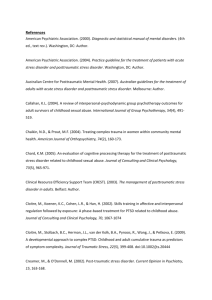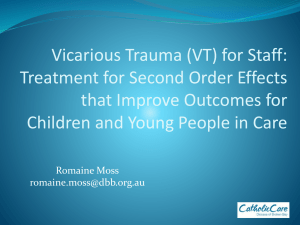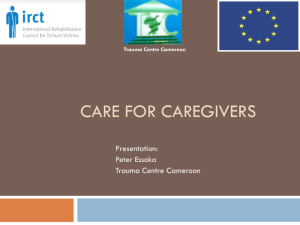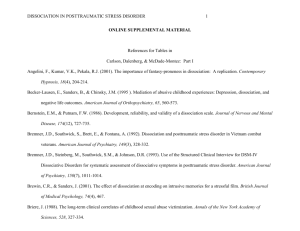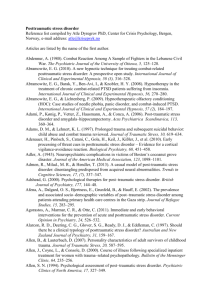PowerPoint Presentation - RSVP Mental Health Recovery
advertisement
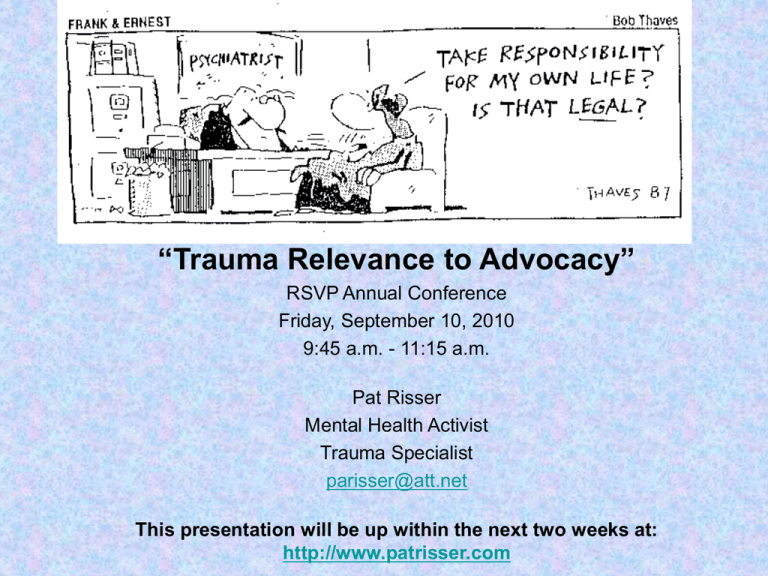
“Trauma Relevance to Advocacy” RSVP Annual Conference Friday, September 10, 2010 9:45 a.m. - 11:15 a.m. Pat Risser Mental Health Activist Trauma Specialist parisser@att.net This presentation will be up within the next two weeks at: http://www.patrisser.com Opening Joke The psychology instructor had just finished a lecture on mental health and was giving an oral test. Speaking specifically about manic depression, she asked, "How would you diagnose a patient who walks back and forth screaming at the top of his lungs one minute, then sits in a chair weeping uncontrollably the next?" Opening Joke A young man in the rear raised his hand and answered, "A basketball coach?" Socrates Rule If you think what you have always thought, You will feel what you have always felt. If you feel the way you have always felt, You will do what you have always done. If you do what you have always done, You will get what you have always gotten. What is Trauma? In common, everyday language usage, "trauma" simply means a highly stressful event. Not all stress is trauma but, all trauma is stress. "Trauma is the personal experience of interpersonal violence, over the life span, including sexual abuse, physical abuse, severe neglect, loss, and/or the witnessing of violence, terrorism, and disasters." From “Criteria for Building a Trauma-Informed Mental Health Service System” (2005), NASMHPD (National Association of State Mental Health Program Directors) What is Trauma? 1. An event (physical, emotional, sexual, psychological, neglect, loss) 2. Beyond normal (dis)stress 3. Unavoidable; no choice(s) Beyond normal (dis)stress 1. Effects of trauma can be cumulative. 2. Human caused trauma often has a greater impact. 3. There is both an objective and a subjective experience of a traumatic event. It is the subjective experience that determines the impact the event will have on a person. An Event One-time incidents Accidents Natural disasters Crimes Surgeries Deaths Chronic or repetitive experiences Child abuse Neglect or enduring deprivation Combat Urban violence Battering relationships As traumatic as single-blow traumas are, the traumatic experiences that result in the most serious problems are prolonged and repeated. Prolonged stressors, deliberately inflicted by people, are far harder to bear than accidents or natural disasters. The worst situation is when the trauma is caused deliberately in a relationship with a person on whom the victim is dependent. Traumatic Events Being hospitalized Being taken into custody Being Tasered or stunned Seclusion or restraints (isolation and bondage) Having your bodily integrity violated (rape, medication injection, ECT) Being forced or regimented (removal of choices) Being betrayed (lies) Having people not believe you or treating you as if you’re stupid Being disrespected or bullied Beyond “normal” (dis)tress Just because a person is depressed, that doesn’t mean they “have depression.” True or False: Every emotion is a disease and every disease has a chemical “treatment.” Feelings and emotions are not a brain disease, disorder or illness. Not every feeling or emotion needs a pill. If it all was a simple and harmless as 'staying on our meds...' then pigs would fly. Unavoidable; no choice(s) In the case of abuse, choices aren’t offered or given. This can be due to the power dynamics of oppression. Those people or institutions in positions of power place severe restriction or limitations on a person or a group who is less powerful. The individual or group is devalued, exploited and deprived of rights, benefits, opportunities, privileges, dignity – even their status as a equal member of the human race. Scope of the Problem Up to 98 percent of public mental health clients diagnosed with severe mental illness have trauma histories. (Mueser, Goodman, Trumbetta, Rosenberg, Osher, Vidaver, Auciello & Foy, 1998). Individuals who have lived through multiple (4 or more) instances of adverse childhood exposure, such as abuse or neglect, are four to 12 times more likely to experience alcoholism, drug abuse, depression, and suicide. Those same individuals are at increased risk for other health risk behaviors, including smoking, multiple sexual partners, STDs, physical inactivity, and severe obesity. (Felitti, Anda, Nordenberg, Williamson, Spitz, Edwards, Koss & Marks, 1998). Scope of the Problem 80% of persons in psychiatric hospitals have experienced physical and/or sexual abuse as children. 90% of persons diagnosed with BPD or DID have experienced some or several forms of abuse/neglect as children. BPD = Borderline Personality Disorder DID = Dissociative Identity Disorder People labeled with Mental Illness Trauma can result in being diagnosed/labeled/ misdiagnosed with the following: • Medical illness and somatization disorder • Post Traumatic Stress Disorder (PTSD) • Substance abuse (SA) or dependence • Borderline Personality Disorder (BPD) • Dissociative Identity Disorder (DID) • Self-inflicted violence (SIV) • Anxiety/panic disorder • Depression • Schizophrenia • Bipolar Disorder • Eating disorders • Sexual promiscuity • Anger management • Behavioral problems People labeled with Mental Illness Frequently, symptoms of PTSD can mimic those of schizophrenia, depression, and anxiety, among others. When mental health providers fail to screen patients for a history of abuse or trauma, the provider may misdiagnose the problem and use treatment that is inappropriate. If trauma is not appropriately diagnosed and treated, treatment for the person's psychiatric issues is usually ineffective. Mentalist attitudes by providers can result in a mistaken belief about “recovery” that a quiet client who causes no community disturbance is deemed “improved” no matter how miserable or incapacitated they may feel as a result of the “treatment.” Mentalist Attitudes “A series of recent studies consistently show that persons with serious mental illnesses in the public mental health system die sooner than other Americans, with an average age of death of 52.” (Colton, C.W., Manderscheid, R.W. (2006) Congruencies in Increased Mortality Rates, Years of Potential Life Lost, and Causes of Death Among Public Mental Health Clients in Eight States. Preventing Chronic Disease. Vol. 3(2).) “Adults with serious mental illness treated in public systems die about 25 years earlier than Americans overall, a gap that's widened since the early '90s when major mental disorders cut life spans by 10 to 15 years.” Report from NASMHPD (National Association of State Mental Health Program Directors), May 7, 2007 “What does it mean that the life expectancy of persons with serious mental illness in the United States is now shortening, in the context of longer life expectancy among others in our society? It is evidence of the gravest form of disparity and discrimination.” Kenneth J. Gill, Ph.D., CPRP Posttraumatic Growth Posttraumatic Growth (PTG) is defined as positive change that occurs (after the traumatic event) as a result of the struggle with highly challenging life crises (trauma). [http://en.wikipedia.org/wiki/Posttraumatic_growth] This is NOT resilience or resistance which is the ability to cope with the event. [Tedeshi, R.G., & Calhoun, L.G. (2004). Posttraumatic Growth: Conceptual Foundation and Empirical Evidence. Philadelphia, PA: Lawrence Erlbaum Associates.] Just because individuals experience growth does not mean that they will not suffer. [Tedeschi, R. G., & Calhoun, L.G. (1995). Trauma and Transformation: Growing in the Aftermath of Suffering. Thousand Oaks, CA: Sage.] PTG does not imply that traumatic events are good. Posttraumatic growth is not universal. It is not uncommon, but neither does everybody who faces a traumatic event experience growth. [Tedeshi, R.G., & Calhoun, L.G. (1996). The Posttraumatic Growth Inventory: Measuring the Positive Legacy of Trauma. Journal of Traumatic Stress, 9. 455-471.] Trauma-Informed Advocacy Event(s) - Create places of safety and give the person your presence; listen with your heart and mind fully engaged; be present with dignity and respect; don’t medicalize, minimize, trivialize, diagnose or get clinical. Don’t use the language of the mental illness system; you’re not “cool” if you talk like them (high-functioning). Beyond “normal” - Believe the person and don’t discount their reality; let the person tell their story; allow the person their feelings (including anger, fear, terror, shock, horror, rage, grief, sadness, disgust, and shame); stay grounded to avoid overwhelm; offer the hope of recovery; be an advocate; take care of yourself and role model wellness; Promote posttraumatic growth. Unavoidable - Offer choices; always ask permission; take steps toward prevention of possible future trauma; believe in “first, do no harm”; help find alternatives. Safety • Physical - Free of violence or threats • Psychological - Free of helplessness, shame, humiliation • Social - Free of mentalist attitudes, isolation, lack of empathy • Moral - Free of discrimination, abuse of power, arrogance, cruelty • Cultural - Free of class distinctions and background disrespect • Medical - Free of harm and given choices based on informed consent Empowerment Scale (for Services) • Level One: The person does not make any substantive decisions about their service. • Level Two: The person does not make any substantive decisions about their service, but is routinely informed about the decisions others will be making on their behalf. • Level Three: The person is routinely asked to give advice, (i.e. is consulted), by the actual decision-makers, about his/her personal service decisions. • Level Four: The person begins to routinely personally make a significant minority of the substantive decisions that constitute their personal service. A significant minority, in statistical terms, might range from 25%-45% of key decisions. • Level Five: The person routinely begins to personally make a significant majority of the substantive decisions that constitute their personal service. A significant majority, in statistical terms, might range from 55%-90% of key decisions. • Level Six: The person is so routinely making the vast majority of key decisions that they simply do not any longer believe that they have a meaningful empowerment issue. Tribal wisdom of the Dakota Indians, passed on from generation to generation, says that, "When you discover that you are riding a dead horse, the best strategy is to dismount.” However, in State and Federal Government more advanced strategies are often employed such as: 1) Buying a stronger whip to urge the horse onward. 2) Changing riders. 3) Appointing a committee to study the horse. 4) Arranging to visit other countries to see how other cultures ride dead horses. 5) Lowering standards so that dead horses can be included. 6) Reclassifying the dead horse as living impaired. 7) Hiring outside contractors to ride the dead horse. 8) Harnessing several dead horses together to increase speed. 9) Providing additional funding and/or training to increase the dead horse's performance. 10) Doing a productivity study to see if lighter riders would improve the dead horse's performance. 11) Declaring that as the dead horse does not have to be fed, it is less costly, carries lower overhead and therefore contributes substantially more to the bottom line of the economy than do some other horses. 12) Rewriting the expected performance requirements for all horses. 13) Promoting the dead horse to a supervisory position.


